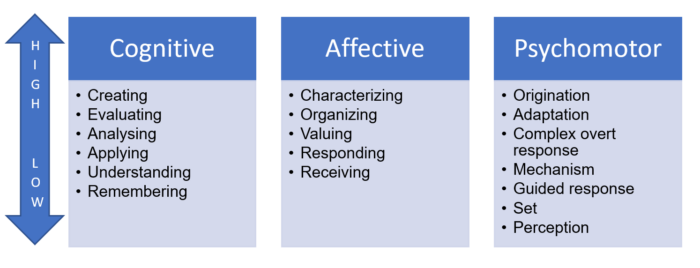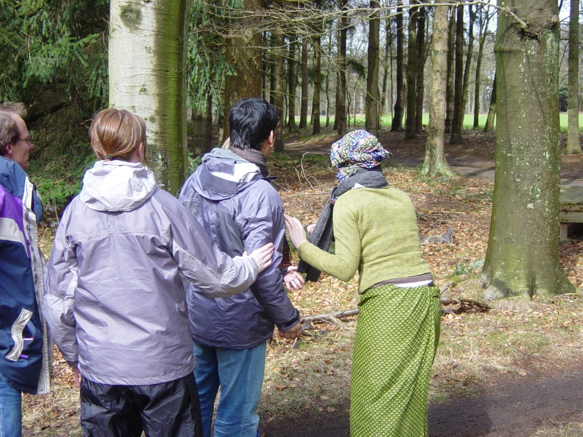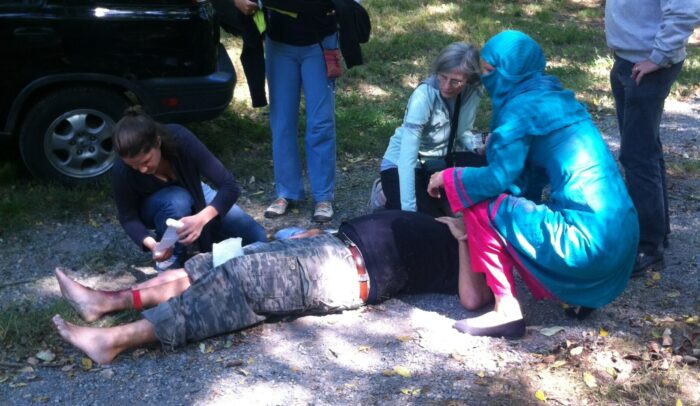Effective HEAT training & three domains of learning
“TELL ME AND I FORGET.
TEACH ME AND I REMEMBER.
INVOLVE ME AND I LEARN.”
BENJAMIN FRANKLIN

Blog by Ebe Brons
What is HEAT training?
Hostile Environment Awareness Training (HEAT) is a multi-day safety and security course that enables participants to work, travel and live in high-risk areas. The goal is learning effective behaviour and practical skills in order to deal with security risks encountered in hostile areas. Practical exercises and hyper-realistic simulations are the main methods of learning in HEAT training courses.
The three domains of learning
HEAT training is always a blend of different learning objectives. Often these objectives (or domains) are mixed but they can be distinguished; cognitive (knowledge-based), psychomotor (action-based) and the affective (emotion-based) domain.
The theoretical (cognitive) part of HEAT training allows participants to understand the information they need to make informed decisions. But the most important purpose of this domain is to support the psychomotor and affective domains.
The main focus of HEAT courses is on skills, behaviour and emotional self-control (psychomotor and affective domain). When participants get into trouble abroad it is often not a lack of knowledge. It is their attitude, behaviour and self-control that increases or decreases their risks. That is why a training with only theoretical components is not a HEAT training.
The psychomotor domain and the affective domain are intertwined. Attitude is reflected in the physical action and posture of a participant. The ‘opponent’ will see the non-verbal communication and will react accordingly. Managing one’s own attitude and posture is of great importance. This allows you to indirectly control a dangerous situation and increases the chance of exiting the situation unharmed.
Domains and levels
The three learning domains have lower level objectives and higher level objectives. These are shown in the diagram below. To make this more concrete, we will discuss the levels using an example of a real-life simulation.
 What is the relevance of these levels?
What is the relevance of these levels?
The levels offer a model to make choices about the complexity and specificity of the learning objectives. Every course has limitations in time, place, staff and means, therefore choices have to be made. The levels provide a basis for these choices. The levels also show which level of expertise is expected from for the trainers and participants.
Case study: Landmine Incident Simulation
During the landmine incident simulation a group of participants has to walk on a road from point A to B. While walking they hear a loud explosion, they see smoke and a victim lying beside the road. His leg is blown off and he is crying for help.
How does the group react? The participants do not rush in but discuss the situation. They know that the victim needs medical assistance as soon as possible. They also know that there might be more landmines. When they approach the victim they might also step on a mine.

After a short discussion they decide not to enter the (possible) minefield. They divide tasks, one has the oversight, one member will talk to the victim, one will offer medical help from a distance and one will contact the HQ and arrange a mine clearance team and an ambulance.
The victim applies a tourniquet on his own leg. The team assists the victim by showing him how to do this. They keep their distance and try to keep him awake until help arrives.
After the simulation the group evaluates the situation together with the trainer. The group articulates what action they took and why. They can reproduce the knowledge they used and how they took the interests of the stakeholders into account.
How can we categorise the levels in this event?
Cognitive domain:
Before the simulation the group started with theoretical lessons in a classroom setting. They remembered and understood the landmine characteristics, landmine-procedures and emergency medical techniques. They have applied and analysed this theoretical knowledge during the simulation. For example, protect your own safety first (Medical knowledge) and if there is one landmine there are probably more (Ammunition Awareness). They were able to articulate and evaluate their decisions and actions after the event. Creating new information did not happen as the participants had to follow the standard procedures.
Psychomotor domain:
The participants have used perception (hearing, seeing etc) to steer their activity. They were set to act. In an early stage they have learned practical skills to help a wounded person. This involved mimicking the trainer, a form of guided response, in order to obtain the medical skills. During the simulation the participants show the movements (mechanisms) needed to apply the tourniquet with some confidence to the victim.
The psychomotor domain has more advanced levels which go from complex overt response (Quick and highly coordinated execution) to origination which implies that you are able to develop new and original skills. During a HEAT training these cannot be achieved due to time limitations. It will take multiple weeks or months to make sure participants reach such a high level of learning.
 Affective domain:
Affective domain:
The participants did not only receive knowledge by attentively listening to the trainer, they also responded by actively participating during the lessons. When we look at the behaviour of the participants during the simulation we see a hierarchy of values that are discussed. The value of the life of the victim is being weighed against the value of the lives of the group and the family member. The lives of the group rank higher in this group. This is a form of organising values.
The values of the group are internal (characterizing) values that do not result in all or nothing behaviour. Although the many lives of the group rank higher, the life of the victim is, of course, also highly important. The group shows this conclusion by helping the victim within the boundaries of their own safety. The provide medical assistance, find an ambulance and a mine clearing team in order to get the victim out of the mine field.
In this case study we see that the cognitive domain checks all but the last level. The last level involves creating original new knowledge. As most theoretical knowledge in this case study is based on protocols and procedures, new original knowledge is not expected from the participants.
Analysis of this simulation
The affective domain checks all levels. It is possible to develop these objectives in a few days. Effective emotional self-control and behaviour is vital for safe deployment in high risk areas. It enables the participants to make the right choices under pressure. This domain is only properly trained in a stressful environment during real-life simulations.
The psychomotor domain checks three levels. To reach this level takes intense and extensive simulations. Higher level objectives would take more time than a few days to develop. For example; the level complex overt response involves highly coordinated movements, quickly applied without hesitation. This level (and higher levels) will take weeks or months of repetition during practical exercises. The time-limit of HEAT courses prevents participants to reach these high levels.
The psychomotor domain is paramount when travelling and working in risk areas. It greatly decreases the risks the participants face. This domain is also the most difficult learning domain to teach. It takes time, repetition and competent trainers to transfer these skills.
 What makes it more complex is that the psychomotor domain is intertwined with the affective domain. Otherwise only extensive practical exercises in a classroom would be enough.
What makes it more complex is that the psychomotor domain is intertwined with the affective domain. Otherwise only extensive practical exercises in a classroom would be enough.
Because of this mixing of domains, skills and behaviour can only be properly trained in real-life simulations. After the course the participants will not face dangerous situations in a clean and comfortable teaching space. They will face risks in a volatile and sometimes chaotic environment. That is why it is key to approach the realities of hostile environments as closely as possible during the course. Hyper-realistic simulations are the only way to give the participants a fair chance of dealing with risks abroad. This makes hyper-realistic training and simulation the main factor of a successful HEAT training.
